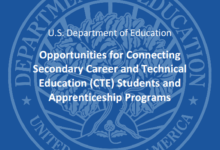The non-traditional gender occupational divide weakens state economies by decreasing economic productivity and reducing diversity in decision-making. By creating gender parity in which “women participate in the labor force at the same rate as men, work the same number of hours as men, and are employed at the same levels as men across sectors,” the United States would see an estimated $4.3 trillion increase in the gross domestic product in 2025. Featuring research by Jean Claude Mbomeda, this brief presents state examples and offers recommendations for Career Technical Education (CTE) leaders on how they can strengthen policies to advance gender parity, ensure equitable access and outcomes for every learner and better meet the needs of the state’s economy and labor market.
This brief is part of the Building a Diverse Leadership Pipelines: Elevating Knowledge briefs that provide policy analysis and recommendations featuring original research by select members of the inaugural cohort of The Postsecondary State Career Technical Education Leaders Fellowship at Advance CTE – Sponsored by ECMC Foundation. Through highlighting this work and positioning the findings as potential action steps for the field, this series aspires to elevate a new and more demographically diverse generation of CTE leaders.







